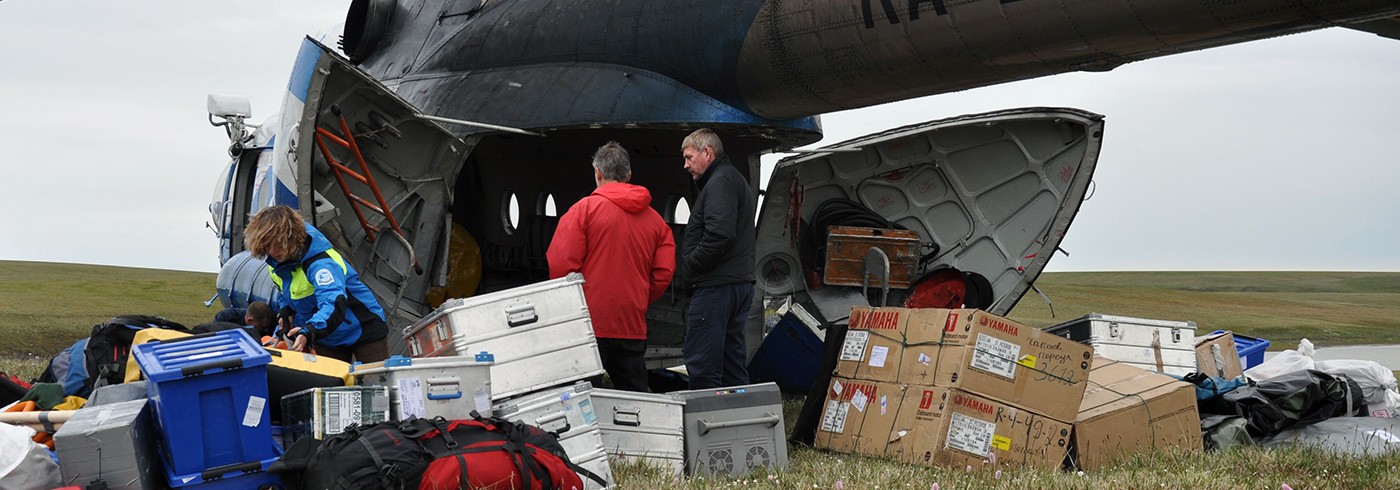Most of the week has just been blue skies, beautiful Taymyr cumulus clouds over our head, and then changing wind speed; no wind mosquitoes, hard wind sand in our ears when working in sections. Monday it was 18 °C in the afternoon, Wednesday it was 24 °C, and on Sunday afternoon an incredible 32 °C, this on the arctic tundra!
We continued working in sections revealing marine sediments, the best section of course – as in 2010 along the Bolshaya Balaknya – being beneath a pelerine falcon’s nest, having three newly hatched ckicks in the nest and one egg to go. The parents dived and screamed at as for the first half hour, but then came to rest, the female just lying there in the nest keeping an eye at as 20 metres away. We also had our first visit by muskox, a large lonely bull strolling along the river on the opposite side of our camp. Continuing with animal business, reindeer had been close to absent this week, whereas we had herd of hundreds of them the week before. However, out of range for us so our hunting success so far has been zero.
Wednesday was time for camp shift, so we sailed downstream to base camp 4, reaching this after 77 km and 11 hours with a good march speed at around 10 km an hour. What a different river now; only some shallow passages that usually was to pass only with drawn-up motors and mostly deep waters in large meanders. Base camp 4 was put up on a sandy point-bar beach and with a view of the Byrranga Mountains in the far background. On our way there at our lunch stop we were amuses by two arctic fox youngsters playing outside their den just 30 metres away.

Photo: Per Möller
Two days of work from base camp 4 has meant different types of sediment and approach than before. We have concentrated on the more recent geologic palaeo-ecological evolution of the area, digging and coring into “ice-complex deposits”, silts and fine sand rich in organic remains divided up by thick ice wedges, and then sandy sediments with a lot of wood within them. From the former type of sediment we know from previous investigations that they often reveal a lot of information on biologic and ecologic change both on macro-, micro- and DNA scale. The latter type of sediment deposit drew our attention as we saw a number of tree trunks standing in up-right position and roots exposed, a forest surface “drowned” in sand.
Our guess is that these trees stems from the last temperature maximum of the area since the last glaciation, approximately some 8000 years ago. This in turn means that the northern tree line was moved at least some 300 km to the north, compared where it is situated today. Our future datings will tell!
.jpg)

Thursday evening was a beautiful such, sun, no wind and quite warm. Most of us took the opportunity to have a bath in the river – helped with a bucket of warm water – and/or washing up some clothes. Crawling around in geologic sections has made both us the cloths quite dirty. During expeditions like this you just have to forget about civilized morning showers. On the other hand; the feeling to get into clean clothes and newly bathed is immense – for a while. For sure you will be dirty again tomorrow!

Logata River. Photo: Per Möller
Friday we were finished with the Logata River. The day before Dima and Andrei had taken one of the boats downstream for 10 km to our depot 1 , filling up canisters with 200 l of gasoline. After a difficult passage with many sand bars in the mouth of the Logata River into the Upper Taymyr River, we passed into this quite mighty river being 300-500 m wide and usually deep. The distance to our next goal, the mouth of the Logata River was too far to reach in one day, so we had an overnight camp after 67 km, and made the final 35 km on Sunday, meaning reaching our base camp 5 in decent time, i.e. mid afternoon.
We are now camped some 100 m from a field station of old a wooden house belonging to the Taymyr Nature Reserve organisation, and a banja was fired up. However, not much of need for that when in comes to temperature this amazingly hot afternoon… This hot day with the landscape faded out in a sort of mist had of course to come with a grand finale – at midnight we heard thunders in the south and it did not take long until the thunder storm hit us with very strong wind gusts and heavy rain. It just took minutes before our tents were flat on the ground and we saved the kitchen tent by folding this down over everything that was inside. After half an hour we were able to satisfactorily raise our sleeping tent again, and crawled in, totally soaked.
Now it is good night; we have to fix the camp into order tomorrow. There is always another day on the tundra!
Per Möller, Lunds universitet

